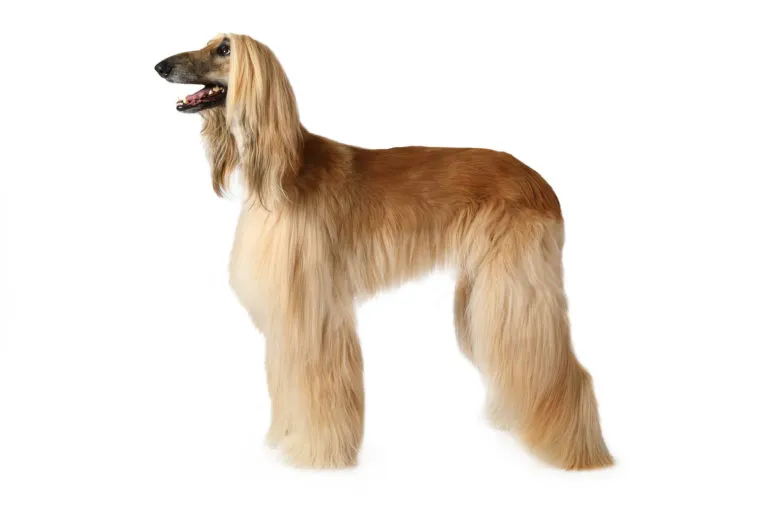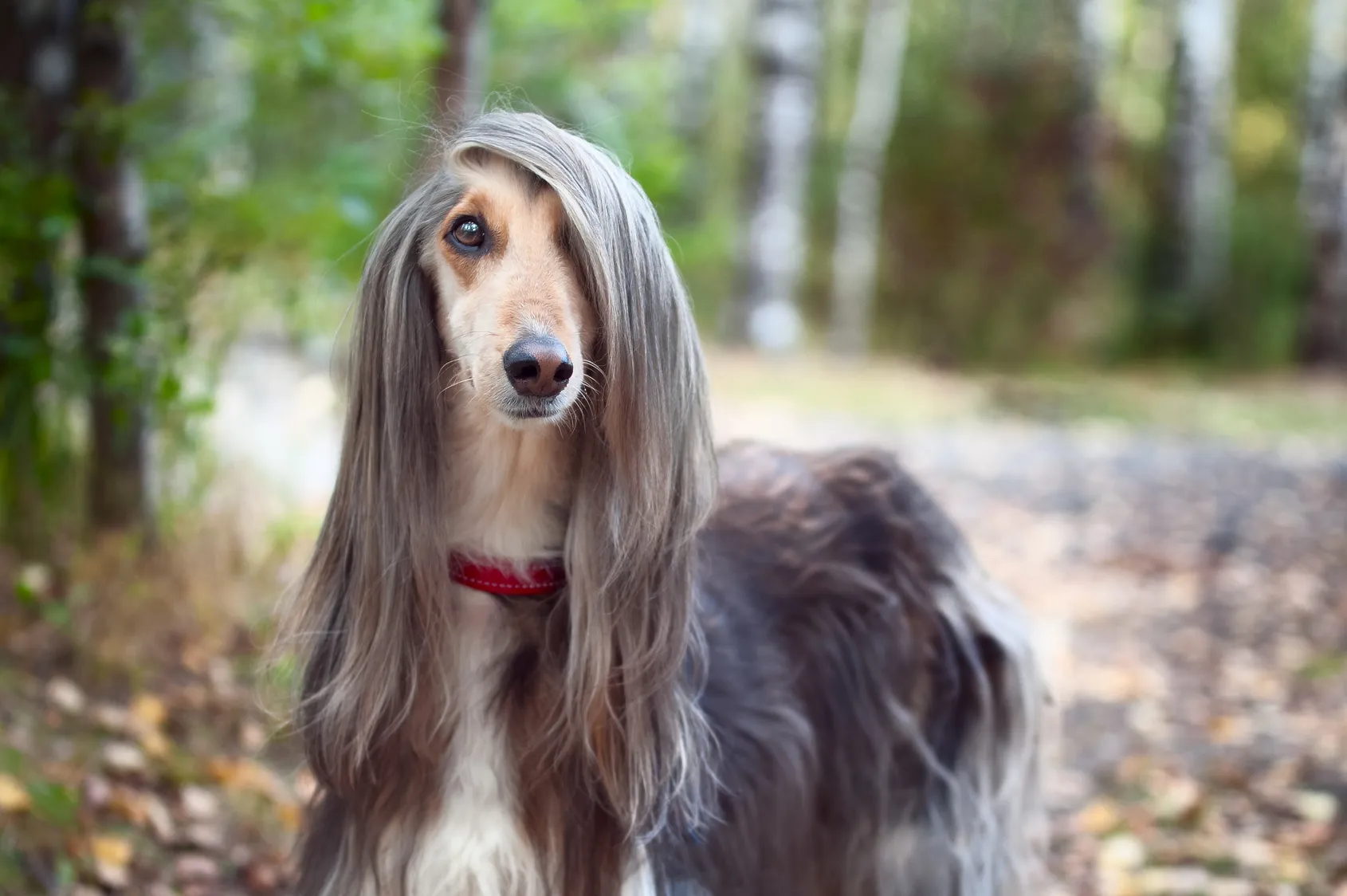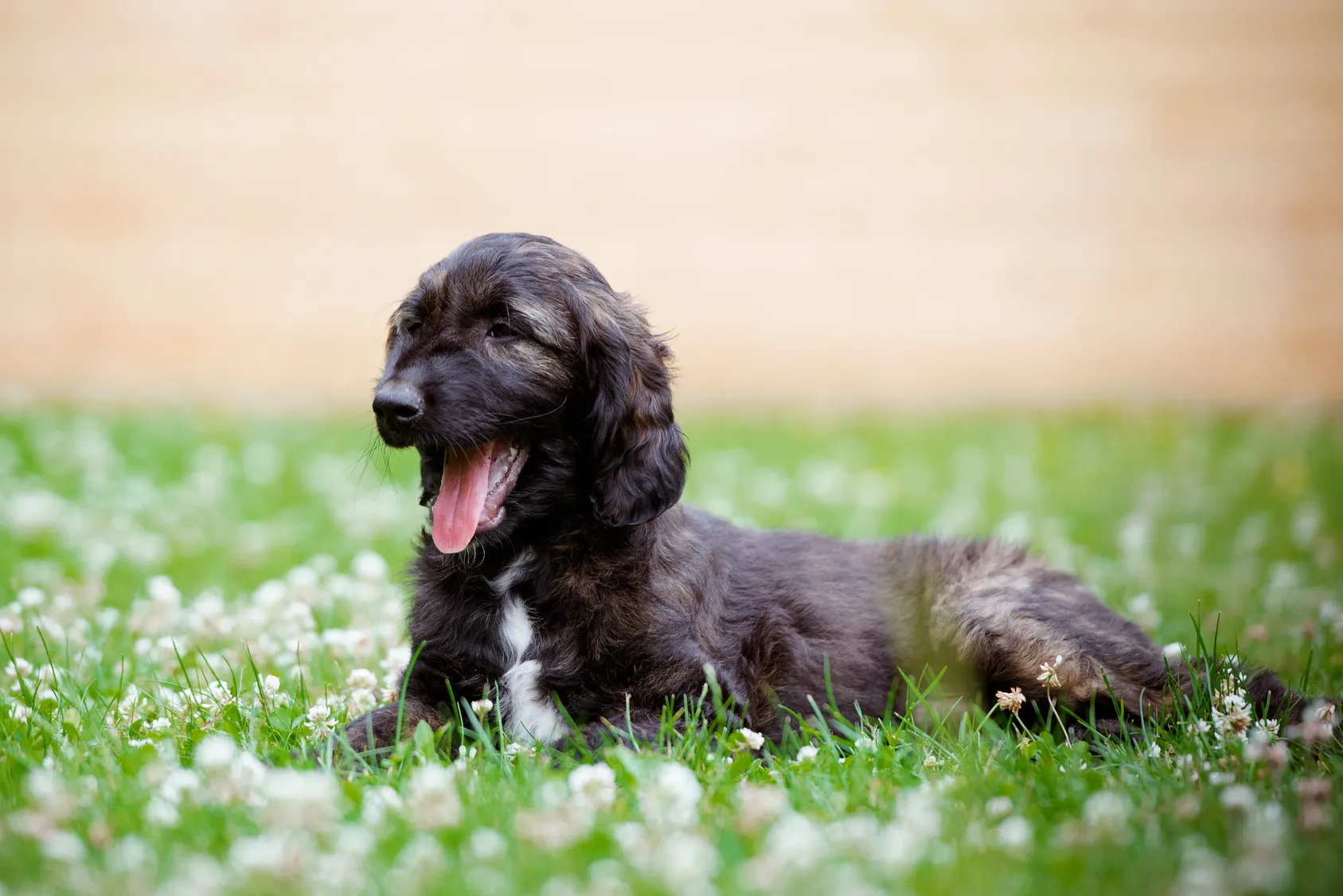Medium Size Poodle
For thousands of years, these fascinating dogs have been considered a treasure in Afghanistan, their country of origin. Nowadays too, these long-haired runners are something special for many dog lovers across the entire world.

© Alexey Kuznetsov / stock.adobe.com
With its long, silky coat, dynamic stature and stately expression, an Afghan Hound is a stunning sight to behold. Males reach a height of up to 74cm and females up to 69cm, whilst these sporting beauties weigh a maximum of 30kg. The long coat, which protected the breed’s ancestors from cold mountain air, is made of thick, silky fur and according to the standard comes in all colours. (find out also the whippet breed)
The ancestors of this venerable breed were part of the oldest canine clans that lived together with humans. In their Afghan homeland, they served the people well for centuries as guard and watch dogs and were predominantly popular hunting companions, where they were mainly deployed for baiting as sight hounds. With toughness and speed, they would hunt everything from rabbits to feline predators. Fellow hunters were held in very high esteem, which also had to do with their standing, since their success was considered essential for survival in the barren desert. Exporting dogs was punishable by the death penalty in their country of origin, but a British officer nevertheless brought the first specimens from Afghanistan to Britain around 1890. At the start of the 20th century, British fans crossed Afghan Hounds of all kinds with each other – both desert and mountain hounds were involved. The resulting puppies represent the start of the modern Afghan Hound breed. In other countries, the breed only became well-known later on. With the increasing popularity of the breed as a fashion and exhibition dog, the metamorphosis of the standard took place: The fur became more voluminous, which limited its success in racing. Nowadays there are different breed lineages depending on the intended purpose – companion dog, exhibition dog or sporting dog – which can deviate from the standard in certain details.
If you’re just looking for a simple, constantly obedient companion, you won’t take any joy in this dazzling canine personality. Originally lone hunters, Afghan Hounds are very independent and self-reliant dogs. They don’t like to play a subordinate role and always know their own mind despite an occasional close connection to their owner. Afghan Hounds don’t have a tendency to yap but are attentive when it comes to their territory and their family. Whilst they mainly behave in a calm manner within their own four walls, outside they can really get going. Due to the incredibly strong hunting instinct, it’s almost impossible to let these sight hounds off the lead, since they are as good as irretrievable once they have potential prey in their sights. Faced with unknown dogs or humans, the Afghan is generally very reticent if not entirely repellent. They are known for their outstanding memory and have this to thank for still knowing after years have passed who has treated them well or badly.
Training an Afghan is for dog experts who will delight in their companion with a strong character. As lone hunters, Afghan Hounds don’t strive to obey their owner and are more focused on independent action than subordination. Nevertheless, you can teach your Afghan Hound basic obedience, but this requires lots of patience and clear, consistent leadership. These sensitive dogs resent harshness, which turns these proud animals into mistrustful and shy companions against their will, which should never be an option. If you’re looking for a dog that will be obey your every word, you won’t have any joy with this breed. However, Afghan fans value these noble dog’s loyalty and their strong personalities. The right balance between stringency and empathy when training this multifaceted character isn’t always easy to strike, so novices can soon be over-challenged.
 © Mariana / stock.adobe.com
© Mariana / stock.adobe.com
If kept in species-appropriate conditions with sufficient activity, the vast majority of Afghan Hounds will in principle be in good health. The breed has a slight disposition to hip dysplasia and cataracts. Myelopathy of Afghan Hounds only occurs amongst this breed and involves a probable hereditary degeneration of the white substance in the throat and chest markings. It mainly emerges before the age of one year and leads to all four limbs becoming totally paralysed within a few weeks. Scrupulous breeders can exclude this illness from their breeds by sensibly choosing which animals to use. In good health, Afghan Hounds live up to 12 to 14 years.
Like all dogs, Afghan Hounds are carnivores, which is why you should make sure that meet is first on the ingredients list of whatever dog food you offer. Should you wish to switch to another food, you’re best off taking a few days to mix the new food in with the familiar one. By doing so, you reduce the risk of irritating the dog’s stomach, which could lead to vomiting or diarrhoea. This also applies when your new housemate moves in: Keep feeding it its usual food for a bit longer in order not to further complicate the housing transition with a change in food too. Whilst puppies receive up to four meals per day, fully-grown Afghan Hounds are fine with two portions and ideally a break afterwards for digestion. Since these sporty dogs use up lots of energy running, daily calorie intake depends greatly on their activity level. Although you can certainly use the manufacturer’s recommendation as a basis for your Afghan’s meals, you should serve slightly more generous portions since they generally need more energy and don’t tend to put on weight. Keep a slim physique in mind and adapt portion size accordingly if your pet gains or loses weight.
The Afghan’s long, silky fur needs to be brushed on a daily basis. This routine is relatively time-consuming, since the fur needs to be brushed in several layers in order to reach all areas and prevent felting. Always brush with care so that you don’t rip any hairs out and get your dog used to the grooming routine with short sessions when it is still a puppy. Remove leaves or fine branches from your dog’s fur after every walk, as these can easily get caught in long hair. Since the coat should develop naturally, the Afghan Hound’s fur should not come into contact either with shearing blades or with scissors. In order to prevent parasites and to keep the coat thoroughly clean, a bath with a mild dog shampoo can make sense if necessary. Some Afghan owners do this every three to four weeks and use a special conditioner along with the shampoo, which makes brushing much easier. When grooming, pay attention to your Afghan’s long ears. You’re best off checking for parasites or alterations to the skin on a daily basis, because the area underneath the ears can quickly become inflamed in warm, humid weather. Your Afghan should wear special “ear protectors” when eating. For this purpose, there are special snoods or “mealtime bonnets” that hold the ears together and thereby prevent your Afghan from biting the hangings of its ears or them constantly ending up in the dog food bowl. It’s best to get your dog used to these ear protectors when it is still in the puppy phase. You can optimise dental care by regularly cleaning your dog’s teeth with a special dog toothpaste and toothbrush, along with giving it dental care snacks.
 © otsphoto / stock.adobe.com
© otsphoto / stock.adobe.com
Exercise should be the cornerstone of your Afghan’s recreational programme. They are happy to accompany you jogging or cycling, but the ideal activity for a greyhound is of course dog racing, in which they really push themselves. Although these dogs have endurance too, speed is their passion, with these sporting aces able to reach up to 60km/h in free rein. In greyhound racing, the competing animals chase a fluttering strip of material or an artificial hare. Coursing is another good form of activity for these action-lovers. This involves an imitation of a sight hunt on a course set in open terrain: the dogs hunt a plastic “hare trail” spread over 500 to 1000 metres in pairs. As soon as the dogs run in pairs, both must generally wear a muzzle like in a race, since the risk of injury when potentially tussling with the prey is otherwise too great. Sports like agility dog are less suited to these runners.
If you wish to have an Afghan as a canine companion, you should likewise be very sporty. Occasional jogging isn’t enough to tire out these exercise-loving dogs. You should also fundamentally be sure of yourself and experienced in handling dogs, because training an Afghan Hound can prove challenging. You should have a large, fenced garden in which these agile dogs can roam freely. Since the sensitive Afghan is no fan of major chaos and generally radiates great calm within the home, a tranquil household with sporty owners is its best option. The breed generally gets on well with children, but they should ideally be slightly older and have internalised respectful treatment of animals, since proud Afghans can occasionally react sensitively to coarse behaviour. Before the dog enters your home, you should clarify with all family members whether they are in agreement on the new canine housemate and that they have no allergies. The breed can be very well socialised with cats in the home as long as the dog is still young. Establish in advance care arrangements for your dog should you fall ill or go on holiday, because they need lots of exercise in these cases too. If you would prefer to take your dog with you on holiday, find out about suitable destinations beforehand.
Along with the purchase price, also factor in the costs for initial equipment (bowls, harness, lead, dog collar, blanket or cushion, dog toys, car insurance and grooming equipment such as brush, dog shampoo etc.), as well as additional ongoing costs (for species-appropriate food, dog tax and liability, routine vet check-ups). Should your pet fall ill, vet costs can of course shoot up rapidly.
Since Afghan Hounds are only suitable for knowledgeable and exercise-loving owners, there aren’t very many breeders. So, if you want an Afghan Hound to be your new housemate, start the search for a responsible breeder early and study announcements of litters from the national pedigree breeding associations. If you have the option of a puppy, you need to meet it in the flesh. You and the puppy should not just have the opportunity to check each other out, but the breeder should also be happy to introduce you to the parent animals and patiently answer your questions on healthcare provision and breeding objectives in terms of type and character. Of course, you should find out in advance if your breeder is specialised in show or sporting dogs. Show dogs occasionally have fur that requires extensive grooming and proves restrictive, whilst dogs from very sporty lineage need more exercise than the “average” Afghan. Make sure that all the animals come across as lively and relaxed and be pleased if your breeder also asks you questions about your experience with dogs, expectations on life with a dog and how you spend your free time, because this shows that they are trying to find a good home for their puppies. The puppies should have received several rounds of vaccinations and deworming treatments when they are handed over, and you should also receive the pedigree certificate, vaccination record and chip identification, as well as a few portions of the usual food. An Afghan hound puppy could cost around £1,000.
Absolutely do not buy a puppy from breeders focused on quality over quantity that do not belong to an association, as they are mainly in it for the money. If you purchase an animal from such individuals, this often supports poor ownership conditions and also leads to the danger of ending up with a sick dog that hasn’t been socialised.
If you’re looking for an older Afghan Hound, you may strike lucky with national umbrella associations, because these often re-home animals that had to be given up by their original owners for numerous reasons. In any case, consider that the character of an adult dog may already be very much set in stone – including the consequences of possible training errors on behalf of the previous owner – meaning that extensive experience with dogs can be advantageous. However, life with a “second-hand dog” can prove a very enriching experience.
| Trait | Description |
| In short | The Afghan Hound is a graceful dog breed with a dazzling personality and an impressive coat and, for thousands of years, they have been considered a treasure in Afghanistan |
| Temperament | Graceful, with a dazzling personality and impressive coat |
| Stubbornness | Independent, strong hunting instinct |
| Height (Females) | 69 cm |
| Height (Males) | Up to 74 cm |
| Weight | 25 to 30 kg, thick and rich fur |
| Grooming | Requires daily care |
| Exercise Needs | A lot of exercise, suitable for fast sports |
| Suitability for Beginners | Not recommended for first-time dog owners |
| Lifespan | 12-14 years |
| Health Predispositions | Hip dysplasia, cataracts, and bloat |
| Price | Around £1,000 |
| FCI Group | 10 |
Here are some purchase proposals curated by the zooplus editorial team
The products featured have been carefully selected by our editorial staff and are available at the zooplus online pet shop. The selection does not constitute advertising for the mentioned brands.
Fans of the Bearded Collie agree that those who aren't familiar with this dog breed simply have to get acquainted with it. And those who have experienced how a Bearded Collie bolts across meadows with its flowing fur, how it rolls around full of energy and joy and how it attentively and observantly takes into account its owners wishes become simply addicted to this original dog breed and its unique charm.
The Goldendoodle isn't a breed, but a pairing between Golden Retrievers and Medium or Standard Poodles. Marketed as a low-maintenance dog for allergy sufferers, this hybrid is enjoying increasing popularity amongst dog lovers, similar to the Labradoodle.